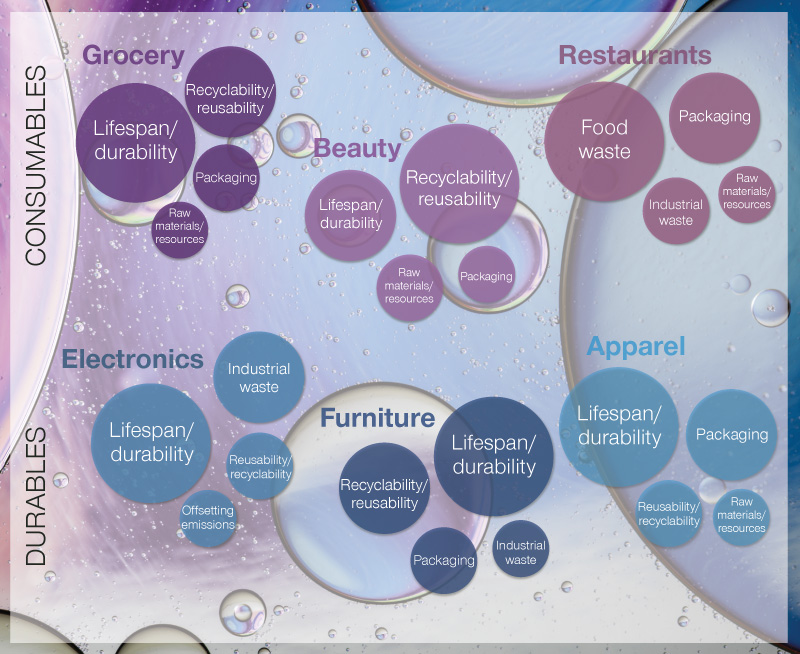Sustainability continues to remain top of mind for consumers in the US - but finding the balance between meeting their needs and willingness to pay will be the key to unlock growth for businesses.
The most recent US results from the annual Simon-Kucher Sustainability Study indicate that an overwhelming majority of respondents, 94 percent, are actively incorporating sustainable practices into their lifestyle and purchasing decisions. How businesses respond to consumer preference will dictate their growth moving forward.
As sustainability gains greater traction, businesses are facing increased pressure to offer more eco-friendly products and services not just from consumers but from regulations and throughout the value chain. Our study revealed that 62 percent of respondents consider sustainability more important now than they did a year ago, indicating that there has been (and likely will continue to be) a shift in consumer attitudes. This trend now extends beyond the early adopters, who have traditionally prioritized sustainability, and now influences the views of those who were previously indifferent to the issue. In fact, half of formerly neutral respondents now consider environmental sustainability a factor in their purchasing decisions, which indicates that sustainability has attracted the attention of the average consumer.
We anticipate that this trend will continue to gain momentum as consumer awareness grows and businesses adapt to their changing preferences. Companies that resist implementing sustainable business strategies risk falling behind, as this trend is likely to become even more prevalent in the future. Those that have already made the shift are well-positioned to capture market share and meet this consumer demand. However, it's essential to remember that innovation and improvement in sustainability is an ongoing process, and businesses must continue to evolve and transform their product offerings to maintain consumer loyalty and remain competitive in the industry.
What this means for sustainability in business
A clear understanding of the mindset and willingness to pay across generations will benefit businesses and their position in the marketplace. As anticipated, younger generations are spearheading the trend towards eco-conscious consumerism and making more sustainable purchasing decisions. Our study revealed that Gen Z is at the forefront of prioritizing sustainability, with 45 percent of Gen Z respondents adopting significant environmentally friendly lifestyle changes. However, it's crucial to note that older generations are not far behind and should not be overlooked. In fact, 43 percent of Millennials, 41 percent of Gen X, and 34 percent of Baby Boomers have all made significant lifestyle changes in the past year to prioritize sustainability.
As consumer goods and retail companies consider product development and marketing value drivers for products appealing to younger generations, sustainability should be at the forefront of their minds. Older generations value sustainability only slightly less than younger generations. However, there is a significant difference in generational willingness to pay for sustainability.
Price is the top barrier to purchasing sustainable consumer goods.
While demand for sustainability is undeniably increasing, the primary obstacle is price, which prevents consumers from fully embracing environmentally sustainable products. For those consumers that prioritize sustainability, affordability is a concern, with 28 percent of respondents citing it as the primary barrier to purchase. Thus, price is a critical factor creating the gap between the consumer’s determination to act sustainably and their actual purchase behavior.
Adapting your sustainability strategy to optimize consumer value while also building margins
There are many factors that need to be considered for a holistic sustainability strategy – (1) from the elements of sustainability that you will capture, (2) how you will message it to target consumers and finally through to (3) the monetization strategy.
1. Identify key category sustainability value drivers
Our recent survey sheds light on the most important factors for American shoppers when making sustainable purchases in the consumer sector. While there are several ways to integrate sustainability into consumer goods, from sourcing reusable materials to buying offsets for emissions, there are four that resonate the most with consumers. This prioritized list can help guide the consumer industry in their efforts to develop eco-friendly products and services that resonate with consumers and warrant premium pricing.
These are the four key sustainability elements prioritized for consumer goods are:
- Lifespan and Durability:
Consumers prioritize products that have a longer lifespan and exhibit greater durability, reducing the need for frequent replacements. This factor not only minimizes waste but also offers economic benefits for the consumers. - Recyclability and Reusability:
Today's eco-conscious consumers appreciate products that can be easily recycled, upcycled or repurposed. By integrating recyclability and reusability into product design, companies can reduce the environmental impact of their goods and appeal to sustainability-minded shoppers. - Packaging:
Sustainable packaging plays a vital role in reducing waste and minimizing the environmental footprint of consumer products. Shoppers are increasingly concerned about excessive or non-recyclable packaging materials. - Raw Materials and Resources:
Consumers are becoming more discerning about the sourcing and processing of raw materials used in the products they purchase. Ethical and responsible sourcing of materials is a crucial aspect of sustainability in the consumer sector.
Consumers’ top sustainability value drivers, by industry

Consumers attribute varying degrees of importance to different elements depending on the specific subcategory of the product they are purchasing. In the case of consumables, which encompass subcategories like grocery, beauty, and restaurants, consumers tend to place a greater value on the ability to recycle a product and the quality of raw materials and resources used. However, when it comes to durable goods, such as electronics, apparel, and furniture products, consumers tend to prioritize factors like lifespan and durability to ensure the longevity of the product.
The significance of durability is evident in the growing trend of younger generations owning more used or refurbished items compared to older generations, as well as the increasing prevalence of pre-owned goods transactions. Gen Z and Millennials are embracing the sustainability benefits of buying used items online and reported that about one third of their consumable goods are not new. However, older generations have not fully adopted the trend of purchasing used goods, with Baby Boomers owning an average of only 18 percent of not new items.
The emerging trend presents a significant market opportunity for selling or renting second-hand or refurbished items. Companies targeting Millennials or Gen Z consumers should consider exploring circular business models, which offer financial benefits for both buyers and sellers and aligns the company with sustainability goals. Integrating a re-commerce or resale marketplace into the business model can provide an ideal opportunity for companies to tap into this growing market trend and capture a new consumer segment.
2. Message key value drivers clearly and authentically
Lack of clear and easy-to-understand information often leads to confusion preventing consumers from buying sustainable goods, which was the case for 17 percent of consumers. Therefore, to ensure the sustainability claims have genuine merit, companies need to ensure messaging is:
- Credible
- Simple and transparent
- Authentic
Certifications are crucial in addressing consumer doubts and confusion regarding sustainability claims and preventing greenwashing. In fact, over half of our respondents across all consumer subcategories ranked certifications as their top communication tool preference to encourage and aid with responsible shopping. This highlights the importance of tailoring the communication of your sustainability standards and certifications to your target consumer.
While the average consumer may not have a sophisticated understanding of all the nuances behind environmental sustainability, it is more important to ensure there is transparency in sustainability efforts. Consumers value authenticity and accept the fact that companies do not meet all the standards of environmental sustainability currently.
3. Adjust price markups to align with willingness to pay
So how can businesses set the right prices for their sustainable products?
Being sustainable is not only good for the environment but can also be good for business. This is evidenced in the willingness to pay as one-third of consumers are willing to pay an average of a 30 percent premium for sustainable items. There are additional differences by demographics as the premium on sustainability increases with younger generations. Gen Z respondents indicated they are willing to pay an average premium of as high as 34 percent for a sustainable product alternative. However, Baby Boomers are not nearly as eager to pay these premiums, and their average drops significantly, down to 13 percent.
Companies can grow their sustainability product sales by aligning pricing strategies of sustainable markups through a holistic approach that incorporates:
- Strategic objectives
- Consumer targeting
- Willingness-to-pay insights
- Competitive analysis
- Variable costs
We can help you take the right sustainability actions
Companies who embrace sustainable strategies now, instead of waiting until it is the norm everywhere, will build loyalty with target consumers. This involves making strategic changes to your business and continuously investing in your sustainability transformation efforts. As younger consumers continue to gain purchasing power, it will not be long before sustainability becomes mandated, and for-profit companies will be regulated on environmental standards.
Sustainability is here to stay. And with the help of our experts, you will soon be able to define a commercial strategy that can serve both your consumers’ and your needs.

